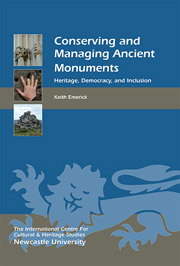Book contents
- Frontmatter
- Contents
- List of Illustrations
- Acknowledgments
- List of Abbreviations
- Introduction
- 1 The Restoration of Hellifield Peel and the Heritage Debate
- 2 The Origins of the Conservation of Ancient Monuments and the Beginnings of State Control in the United Kingdom
- 3 Practice Perfected: the Ancient Monuments Act of 1913 and the Consolidation of State Preservation Practice
- 4 British Conservation Practice in Cyprus, 1878 to 1939: a Case Study
- 5 Current Directions in England: the Emergence of Cultural Heritage Management and the Use of Conventions, Charters and Principles
- 6 Putting Theory into Practice
- 7 Conclusion: Ending the Tyranny of Ruskin and Morris?
- Appendices
- Bibliography and References
- Index
6 - Putting Theory into Practice
Published online by Cambridge University Press: 05 August 2014
- Frontmatter
- Contents
- List of Illustrations
- Acknowledgments
- List of Abbreviations
- Introduction
- 1 The Restoration of Hellifield Peel and the Heritage Debate
- 2 The Origins of the Conservation of Ancient Monuments and the Beginnings of State Control in the United Kingdom
- 3 Practice Perfected: the Ancient Monuments Act of 1913 and the Consolidation of State Preservation Practice
- 4 British Conservation Practice in Cyprus, 1878 to 1939: a Case Study
- 5 Current Directions in England: the Emergence of Cultural Heritage Management and the Use of Conventions, Charters and Principles
- 6 Putting Theory into Practice
- 7 Conclusion: Ending the Tyranny of Ruskin and Morris?
- Appendices
- Bibliography and References
- Index
Summary
‘Does conservation practice deny time, occupancy and decay – and what opportunities can arise through architectural failure?’
Sarah Entwistle, Lecturer, Architectural Association, LondonIntroduction
In this chapter I will present a number of case studies to illustrate the problems and possibilities of blending theory and practice. The examples are drawn from past projects: the first follows a community consultation concerning a Roman fort; the second provides a slightly different perspective on recent work at Castleford, West Yorkshire, and illustrates the role of the individual in heritage management, particularly in relation to ideas about class. The final example is that of an entirely fortuitous meeting (and its consequences) during a site meeting about monument repair. The three examples may further clarify the concept of social value, which will be coupled with a proposed model for cultural heritage management practice.
As an introduction to the case studies it is worth identifying what the practical limitations to conservation interventions might be when applied to ancient monuments and the way in which fabric, evidence and avoidance of conjecture predominate. Most practitioners would agree that there is a set of high level principles:
– whatever is done has to be reversible, of its time and visible;
– do not use untried techniques or materials;
– do not change the site narrative;
– only replace material where failure to do so would result in greater structural loss.
- Type
- Chapter
- Information
- Conserving and Managing Ancient MonumentsHeritage, Democracy, and Inclusion, pp. 189 - 218Publisher: Boydell & BrewerPrint publication year: 2014



